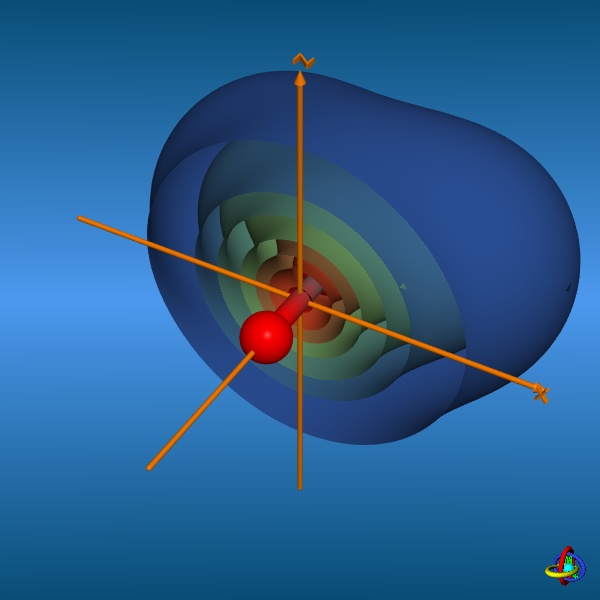| TUD Organische Chemie | Immel | Tutorials | Orbitals | Molecular | Formaldehyde | View or Print (this frame only) |
The molecular orbitals (MOs) of molecules can be constructed by linear combination of atomic orbitals (LCAO).
Though the exact Schrödinger equation is unsolvable for many electron systems such
as molecules, the solution can be numerically approximated by ab initio or density functional (DFT) theory.
This page gives an overview on the molecular orbitals of formaldehyde calculated by DFT methods using a B3LYP/6-311++G** basis set. All MO representations are 90% or 90-25% iso-contour probability surfaces of the electron density (ψ2), i.e. they resemble the spatial volume around the nuclei of the molecule in which the electrons are found with the corresponding certainty. The different colors (yellow and blue) represent regions with opposite sign of the wave function ψ; nodal planes (not necessarily real "planar" planes) were ψ passes through zero and changes sign are indicated in orange.
Click on the small images below with blue background below to obtain an enlarged view - the images with black background provide links to the corresponding 3D-models (VRML-type models); these links will open in a new window. |
|
|||||||||||||||||||||||||||||||||||||||||||||||||||||||||||||||
The total electron density (clipped 99, 95, 90, 80, 70, 60, and 50% iso-density contours depicted on the right) render the molecule with its characteristic shape
(note the different iso-contour values of the MO orbitals and the total electron density contours).
|
|
|||||||||||||||||||||||||||||||||||||||||||||||||||||||||||||||
Below on the right, the schematic drawing indicates the major contributions of atomic orbitals (AOs) to the molecular orbitals (MOs) of formaldehyde.
With increasing energy of the orbitals (from bottom to top), the number of nodal planes (not necessarily real "planar" planes) increases and the symmetry decreases.
For formaldehyde, there are 16 electrons (CH2O, 6 + 2×1 + 8 = 16 electrons) and eight occupied orbitals. The two lowest-energy orbitals
involve the carbon and oxygen 1s-core orbitals in bonding and anti-bonding combination, respectively (total of four electrons, orbitals not shown here).
The remaining six valence MOs are constructed from the carbon and oxygen
2s,
2px,
2py,
2pz, and hydrogen
1s-orbitals.
Note that the bonding orbital of the π-bond of formaldehyde constructed from the 2pz AOs (orbital no. 7 below) is not the highest occupied orbital, but the non-bonding (i.e. a free electron pair of the oxygen atom) constitutes the highest occupied molecular orbital (HOMO, orbital no. 8). However, the lowest unoccupied molecular orbital (LUMO, orbital no. 9) is the anti-bonding orbital of the π-bond. Furthermore, the LUMO (orbital no. 9) is characterized by larger atom orbital coefficients at the carbon atom (the opposite hold for its counterpart orbital no. 7, which has the larger AO coefficient at the oxygen atom). Therefore nucleophiles (potentially negatively charged reagents with a high-energy occupied molecular orbital HOMO, which interacts with the LUMO of the corresponding substrates, i.e. formaldehyde in this case) always attack the carbon atom rather than the oxygen. Electrophiles (which are potentially positively charged reagents with a low-energy unoccupied molecular orbital LUMO, which interacts with the HOMO of the substrate) always attack the carbonyl oxygen atom. The thumbnail images on the left provide access to enlarged graphics as well as 3D-models (VRML) of the orbitals, respectively. Further informations on AOs are available from the gallery of hydrogenic orbitals and hybrid orbitals. |
||||||||||||||||||||||||||||||||||||||||||||||||||||||||||||||||
Notes: a) Orbital number (see scheme on the right); b) Label (symmetry descriptor in parenthesis); c) Nodal planes (ψ = 0.0); d) 90% Probability contours of MO electron density (ψ^2); e) 90, 80, 70, 60, 50, 40, and 25% Probability contours; f) 3D-Models require a VRML plugin to be installed (large files with sizes between 400-1400 KBytes). |
|
|||||||||||||||||||||||||||||||||||||||||||||||||||||||||||||||
For a more detailed description of atomic orbitals see the corresponding gallery of orbitals.
All graphics and iso-contour surfaces shown on this page were created using the MolArch+ program
and POVRAY Persistence of Vision Raytracer. Electron densities were calculated
on three dimensional grids for the corresponding molecules using the JAGUAR program.
|
||||||||||||||||||||||||||||||||||||||||||||||||||||||||||||||||
































